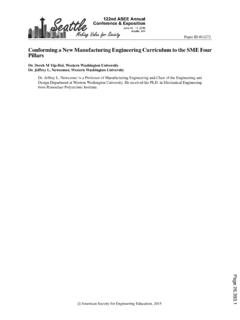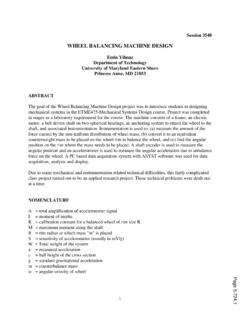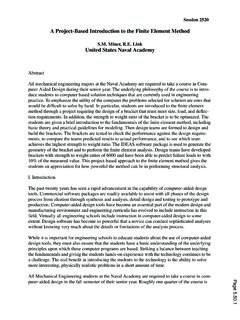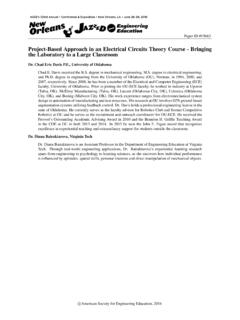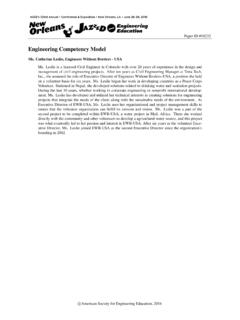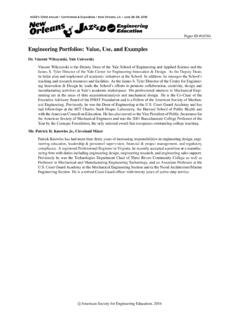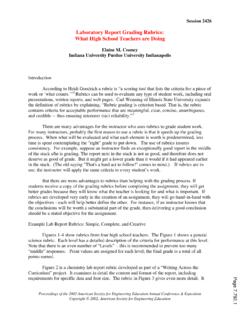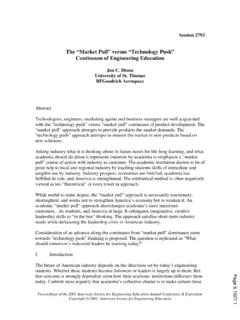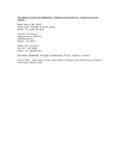Transcription of Breguet's Formulas For Aircraft Range & Endurance An ...
1 Session 1265. Breguet's Formulas for Aircraft Range & Endurance An Application of Integral Calculus Colonel Kip P. Nygren, Major Robert R. Schulz United States Military Academy Introduction At the United States Military Academy, faculty attempt to expose cadets to highly integrated learning scenarios. In an effort to reinforce that the world is not compartmentalized similar to the academic environment, the Department of Mathematical Sciences conducts sessions known as Interactive Lively Applications Projects (ILAPs). In particular, the engineering curriculum provides an excellent base of support to highlight the applications of single and multivariable calculus. This paper focuses on one such ILAP using the Breguet Range and Endurance equations as the foundation for some insight into the physical significance of integral calculus.
2 In a recent semester, members of the Department of Civil &. Mechanical Engineering sponsored an ILAP where cadets Figure 1. Typical US Air Force Airplane learned how integral calculus supports airplane design. Aircraft Performance Parameters Knowledge of the requisite Aircraft velocity for maximum Range and maximum Endurance operations is essential for air crews to optimize flight performance. Engineers focus on maximum Range and maximum Endurance characteristics to optimize the Aircraft design for a specific mission. This information is also pivotal in the marketing of the Aircraft . The need to understand maximum Range and maximum Endurance characteristics of an Aircraft cannot be understated. Specific examples of Aircraft designed for these conditions include Burt Rutan's Voyager (maximum Range ), Unmanned Aerial Vehicles (maximum Endurance ), U-2 reconnaissance Aircraft (maximum Range and altitude), and the P-3 Orion submarine hunter (maximum Endurance ).
3 At the most basic level, the Range and Endurance of an Aircraft depend directly on the quantity of fuel available and the rate at which the fuel is consumed per distance traveled or per hour in the air. Given an unlimited amount of fuel, any Aircraft could fly continuously until, of course, the Aircraft experiences a failure. This is the concept of aerial refueling used by the Air Force. However, fuel availability for practical Aircraft is limited. Therefore, the characteristics of the Aircraft and the environment that affect the maximum Range and Endurance must be found. Such a situation involving several variables is a natural application of multivariable calculus. In addition, the total Range and total Endurance are functions of the Aircraft weight, which is changing continuously as fuel is consumed.
4 Page 1996 ASEE Annual Conference Proceedings In an introductory calculus or Table 1. Basic Parameter Definitions. engineering course, a simple model of the lbs of fuel used problem is most appropriate. Accordingly, c = Specific Fuel Consumption =. several assumptions help to simplify the Range lbs of thrust * hr and Endurance problem while retaining the Lift Non-dimensional Lift Coefficient: CL =. physical significance. This ILAP included the 1. following assumptions: V 2 S. 2. Drag 1. For a particular operating point, Non-dimensional Drag Coefficient: CD =. 1. the Aircraft consumes fuel at a constant rate V 2 S. per pound of jet thrust or per engine 2. horsepower. This rate is known as the Where: Specific Fuel Consumption (SFC), and this S = Wing Planform Area = Air Density example highlights the thrust of a turbine Aircraft .
5 The same type analysis applies to propeller driven Aircraft . 2. The drag coefficient varies as the square of the lift coefficient. A parabolic drag relationship assumes that the skin friction drag coefficient between the air and the Aircraft surface is constant and the non- dimensionalized drag created by the lift force depends quadratically on the non-dimensionalized lift. The equation for what is commonly referred to as a parabolic drag polar becomes C D = C D0 + k * C L2 . 3. The flight profile for maximum Range and maximum Endurance Lift requires the Aircraft to be in a cruise configuration. While in cruise, an Aircraft is in level or near-level flight. This means that the lift vector is Thrust Drag equal and opposite to the weight vector.
6 Also, the thrust and drag vectors are equal and opposite, and both are normal to the lift (Figure 2). Using Weight the relationships shown in Table 1, this assumption establishes the Figure 2. Cruise configuration W2 1. relationship between the Aircraft velocity and weight, V = . S CL. Such assumptions for the mathematical model permit insight into the real world problem without significantly altering the problem. The engineering application then also serves to demonstrate the utility of calculus and motivates cadets to better understand the importance of calculus. Ultimately, cadets learn that the world is an integrated environment where they must draw on their knowledge of many subjects in order to solve an actual problem.
7 The Breguet Equations Once the simplifying assumptions have been made, the basis of this problem is the change of the Aircraft weight over the change in time. The weight of the Aircraft decreases by the weight of the burned fuel. Stated mathematically, using distance and then time as the independent variable, one obtains: dx V CL 1 dt 1 CL 1. = = . dW c CD W dW c CD W. Combining these physical facts with other known relations shown in Table 1, one derives the well known Breguet equations for Range and Endurance . These equations are differential in form and relate the Page 1996 ASEE Annual Conference Proceedings change of Aircraft weight to other Aircraft parameters. The Range and Endurance of the Aircraft depends on the sum of these small differential weight changes.
8 Thus, integrating these equations, one finds the total Range and total Endurance . W Land V CL 1. X destination X takeoff = Range = c CD W. dW. WTO. W Land 1 CL 1. Tdestination Ttakeoff = Endurance = c CD W. dW. WTO. At this point, there are several variables inside of the integral sign and the relationship of each of these variables to weight must be defined before the integration can be completed. The most appropriate assumption is to hold two of the three critical parameters ( , V, CL/CD) constant over the Range of the integration. Each mathematical assumption has a physical analog, and these analogies are shown in Table 2. The need to hold two variables constant is a mathematical, not a physical requirement.
9 While the air crew can operate with exactly these variables held Table 2. Range and Endurance parameters constant, such conditions are not mandatory. For example, the air crew can vary the Aircraft 's Physical interpretation Mathematical interpretation velocity, altitude and angle of attack constant angle of attack constant CL/CD. simultaneously. If, however, the air crew varies constant altitude constant . only one parameter, the correlation between the constant velocity constant V. physical results and the mathematical model is very good. Table 3. Range and Endurance Solutions For constant altitude ( ) and lift coefficient (CL): For constant velocity (V) and lift coefficient (CL): V C L Wo Range =. 1 2 2 CL. c S C D.
10 (. Wo W1 ) Range = ln c CD W1. 1 C L Wo Endurance =. 1 CL Wo ln Endurance = ln c C D W1 c C D W1. For constant velocity (V) and constant altitude ( ): V k k . Range = tan 1 Wo tan 1 W1.. c kC Do 1 V 2 S C 1 V 2 S C . 2 Do 2 Do .. 1 1 1 . Endurance = tan 1 . c kC Do W1. 2 1 . 1 Wo ( ). Where: W0 = Takeoff Weight W1 = Landing Weight Page 1996 ASEE Annual Conference Proceedings The constant parameter assumption allows the engineer to obtain an analytical solution to this problem. Since there are three parameters, there are three combinations of holding two parameters constant. The three mathematical solutions are shown in Table 3. By themselves, these equations contain little significance to an air crew or an aerospace engineer.


